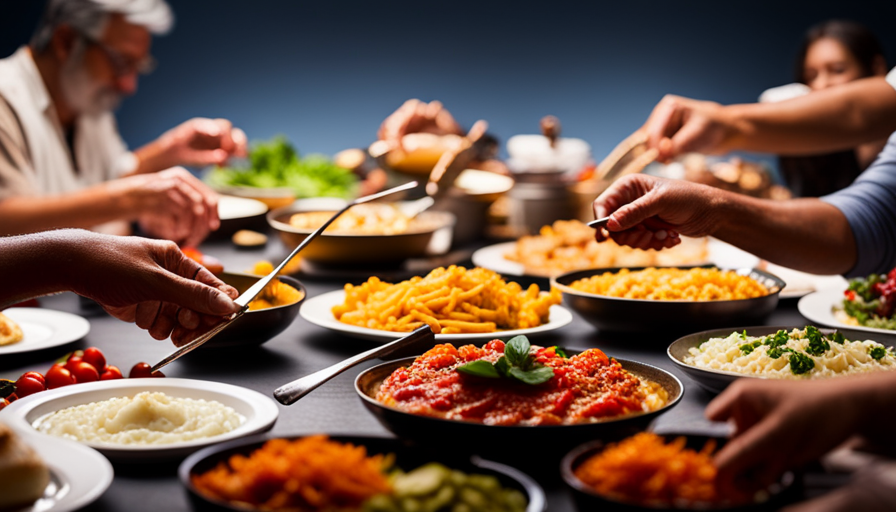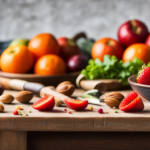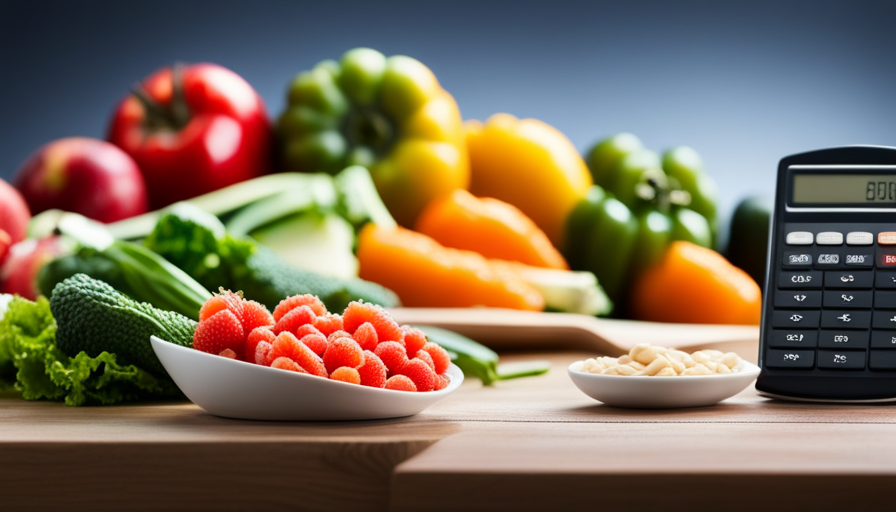Have you ever heard of the theory that a raw food diet is the key to optimal health? It’s a captivating idea, right? The belief that by consuming only raw, unrefined foods, we can unlock a state of vibrant health and boundless energy.
But before you jump on the raw food bandwagon, it’s important to consider the evidence and weigh the potential risks and benefits. As someone who has extensively researched and studied nutrition, I feel compelled to share with you the truth about the raw food diet.
While there are certainly some positive aspects to this approach, there are also several reasons why it may not be the best choice for everyone. In this article, we will explore the potential pitfalls of a raw food diet, from nutritional imbalances and potential nutrient deficiencies to digestive challenges and limited food choices.
So, before you swap your stove for a blender, let’s dive in and uncover the truth about the raw food diet.
Key Takeaways
- Raw food diet may lead to deficiencies in essential nutrients such as vitamin B12, iron, calcium, and omega-3 fatty acids.
- Raw foods can be harder to digest, causing bloating and discomfort.
- Raw foods may be contaminated with harmful bacteria, so precautions should be taken to reduce the risk of bacterial contamination.
- Following a raw food diet requires extensive meal planning and preparation, including the need for specific kitchen skills.
Lack of Nutritional Balance
You can’t rely solely on raw fruits and vegetables to provide all the essential nutrients your body needs, leaving you feeling as empty as a barren field. While raw food enthusiasts argue that cooking destroys some nutrients, it’s important to note that cooking can also enhance nutrient absorption in certain foods. For example, cooking tomatoes increases the bioavailability of lycopene, a powerful antioxidant.
Additionally, some nutrients like beta-carotene found in carrots are better absorbed when cooked.
A lack of nutritional balance is a key concern when following a raw food diet. Certain essential nutrients, such as vitamin B12, are primarily found in animal products. Without proper supplementation or intake of fortified foods, those following a raw food diet may be at risk of developing nutrient deficiencies. This can have serious consequences for long-term sustainability and overall health.
Furthermore, a raw food diet may not provide adequate amounts of other important nutrients like iron, calcium, and omega-3 fatty acids, which are commonly found in animal-based products. These nutrients are crucial for various bodily functions, and their deficiencies can lead to fatigue, weakened immune system, and impaired cognitive function.
While a raw food diet can offer benefits like increased fiber intake and reduced calorie consumption, it’s important to consider the potential nutrient deficiencies associated with this eating pattern. Transitioning into the subsequent section about potential nutrient deficiencies, it’s crucial to understand the importance of a well-rounded diet that includes a variety of foods to ensure optimal health.
Potential Nutrient Deficiencies
One potential downside of following a raw food eating plan is that it can leave you with nutrient deficiencies, like a car running on empty. While raw foods can be rich in vitamins and minerals, it’s important to note that certain nutrients are more difficult to obtain from raw sources alone. Two common deficiencies associated with a raw food diet are protein deficiency and vitamin deficiency.
Protein is essential for building and repairing tissues, as well as supporting a healthy immune system. While raw foods like nuts, seeds, and legumes do contain protein, they may not provide enough to meet your daily needs. This can lead to muscle weakness, fatigue, and poor immune function.
In addition, some vitamins, such as vitamin B12 and vitamin D, are primarily found in animal products or fortified foods. Without these key nutrients, you may experience fatigue, weakness, and an increased risk of infections.
To illustrate the potential nutrient deficiencies of a raw food diet, consider the following table:
| Nutrient | Recommended Daily Intake | Raw Food Sources |
|---|---|---|
| Protein | 46-56 grams | Nuts, seeds, legumes |
| Vitamin B12 | 2.4 micrograms | Animal products, fortified foods |
| Vitamin D | 600-800 IU | Sun exposure, fortified foods |
It’s important to be aware of these potential deficiencies and take steps to ensure you’re meeting your nutritional needs through supplementation or careful meal planning. Transitioning to the next section, let’s now discuss the digestive challenges that can arise from a raw food diet.
Digestive Challenges
Transitioning to the digestive challenges that can arise from a raw food eating plan, it’s important to be aware of how your body may respond to this type of diet. While a raw food diet can certainly provide many health benefits, it can also present challenges for your gut health and nutrient absorption.
One potential challenge is that raw foods are often harder to digest compared to cooked foods. Raw fruits and vegetables contain more fiber, which can be difficult for some individuals to break down completely. This can lead to bloating, gas, and stomach discomfort. Additionally, some raw foods contain compounds that can interfere with nutrient absorption. For example, raw spinach and kale contain oxalates, which can inhibit the absorption of calcium and iron.
Another issue is that a raw food diet typically limits the intake of certain foods that are easier to digest and provide essential nutrients. For instance, cooked grains and legumes are easier on the digestive system and provide important sources of protein, vitamins, and minerals. By excluding these foods, individuals on a raw food diet may be at risk for nutrient deficiencies.
Moving on to the next section about limited food choices, it’s important to understand how this aspect of a raw food diet can impact your overall health and well-being.
Limited Food Choices
With limited food choices, it’s important to consider the potential impact on your health and well-being when following a raw food eating plan. While some may find the simplicity of a raw food diet appealing, it’s crucial to be aware of the food restrictions that come with it. Raw food enthusiasts must avoid all cooked and processed foods, which can lead to deficiencies in certain nutrients such as vitamin B12, iron, and omega-3 fatty acids.
Additionally, the limited variety of foods available on a raw food diet may make it challenging to meet all of your nutritional needs. Taste preferences can also play a role, as not everyone enjoys the flavors and textures of raw fruits, vegetables, and nuts.
-
Nutritional deficiencies: Following a raw food diet can result in deficiencies in certain essential nutrients.
-
Limited food choices: The restricted nature of a raw food diet may make it difficult to consume a balanced and varied diet.
-
Taste preferences: Not everyone enjoys the flavors and textures of raw foods.
Considering these factors, it’s important to carefully evaluate whether a raw food diet aligns with your individual health goals and preferences. Transitioning to the next section, it’s also essential to be aware of the potential risks of bacterial contamination in raw foods.
Potential Bacterial Contamination
To fully understand the potential risks of bacterial contamination in raw foods, you should consider the importance of food safety and how it can impact your health and well-being.
Food safety concerns are a major issue when it comes to consuming a raw food diet. Raw foods, such as fruits, vegetables, and nuts, can easily become contaminated with harmful bacteria like E. coli or Salmonella during cultivation, harvesting, and processing. These bacteria can cause serious illnesses, including food poisoning, which can have a detrimental impact on your gut health.
Foodborne illnesses can lead to symptoms like diarrhea, vomiting, abdominal pain, and fever, which can disrupt the balance of bacteria in your gut. This imbalance can negatively affect your digestion, nutrient absorption, and overall gut health. Additionally, some studies have shown that raw foods, especially those that aren’t properly washed or handled, can harbor more bacteria than cooked foods.
Therefore, it’s important to take necessary precautions to reduce the risk of bacterial contamination when consuming raw foods. This includes thoroughly washing fruits and vegetables, buying from reputable sources, and properly storing and handling raw foods. By ensuring food safety, you can protect your gut health and minimize the potential risks associated with a raw food diet.
Transitioning into the next section about the difficulty in meeting caloric needs, it’s important to understand that while raw foods may offer certain health benefits, they can also present challenges in terms of meeting your daily caloric requirements.
Difficulty in Meeting Caloric Needs
Little did I know, trying to sustain myself solely on raw fruits and vegetables would turn into a never-ending battle of trying to consume enough calories to keep my energy levels up. While raw foods can be nutritious, they often lack the necessary protein to meet our daily needs. Protein is crucial for various bodily functions, including muscle repair and hormone production. Without enough protein, I found myself feeling weak and fatigued on a daily basis.
Meeting protein needs on a raw food diet can be challenging. Although fruits and vegetables contain some protein, they’re not as dense in protein as animal-based foods. To compensate, raw foodists often rely on plant-based sources such as nuts, seeds, and legumes. However, these sources may not provide enough protein to meet the recommended daily intake. Inadequate protein intake can lead to muscle wasting, weakened immune function, and impaired growth and development.
Moreover, following a raw food diet can pose potential health risks. Raw foods aren’t completely free from bacteria and can harbor pathogens that cause foodborne illnesses. This is especially concerning for individuals with compromised immune systems, such as the elderly, pregnant women, and children. It’s essential to thoroughly wash and handle raw fruits and vegetables to minimize the risk of bacterial contamination.
While the raw food diet may have its benefits, it’s essential to consider the difficulty in meeting protein needs and the potential health risks. Transitioning into the subsequent section about ‘potential weight loss or gain,’ it’s evident that sustaining oneself solely on raw fruits and vegetables can have significant implications on body weight.
Potential Weight Loss or Gain
Transitioning into the discussion on potential weight loss or gain, the impact of solely consuming raw fruits and vegetables can be visually striking on the body. While some individuals may experience weight loss due to the low-calorie nature of raw foods, others may actually gain weight. This can be attributed to several factors such as increased consumption of high-calorie nuts and seeds, or the body’s natural response to the decreased availability of energy from cooked foods.
To further illustrate the potential weight effects of a raw food diet, consider the following table:
| Potential Weight Loss | Potential Weight Gain | Neutral Effect |
|---|---|---|
| Calorie deficit | Calorie surplus | Calorie balance |
| Increased fiber intake | Increased fat intake | Balanced macronutrients |
| Improved digestion | Increased portion sizes | Adequate hydration |
It is important to note that weight changes on a raw food diet may vary from person to person, and individual factors such as metabolism and overall health play a significant role. Additionally, it is crucial to consider the health risks and long-term effects associated with this type of diet. While a diet rich in fruits and vegetables can provide essential nutrients, it may also lead to deficiencies in certain vitamins, minerals, and proteins.
Transitioning now to the subsequent section about social limitations and challenges, it is important to understand how a raw food diet can impact our everyday lives.
Social Limitations and Challenges
Transitioning from the potential weight loss or gain associated with a raw food diet, we now move on to discussing the social limitations and challenges that may arise when following this way of eating.
One of the most common challenges is the social stigma that can be attached to a raw food diet. While some people may be supportive, others may question your choices or even make fun of them. This can lead to feelings of isolation or exclusion, making it difficult to maintain the diet in social settings.
Emotional challenges can also arise when following a raw food diet. It can be frustrating when others don’t understand or respect your dietary choices, which may lead to feelings of resentment or even guilt if you’re unable to stick to the diet in certain situations. Additionally, social events centered around food can become more challenging, as you may feel limited in what you can eat or worried about how others will perceive your choices.
Transitioning into the subsequent section about the time and effort required for meal preparation, it’s important to consider how these social limitations and challenges can impact your overall experience with a raw food diet.
Time and Effort Required for Meal Preparation
Preparing meals on a raw food regime can be a time-consuming and laborious task, leaving you wondering if you have enough hours in the day to chop, blend, and spiralize your way to culinary perfection. Meal planning becomes crucial to ensure a well-balanced diet, as it requires careful consideration of nutrient intake and variety.
Additionally, raw food diets often involve extensive kitchen skills, such as soaking nuts, sprouting grains, and fermenting vegetables. These techniques not only demand time and effort but also require knowledge and practice to execute correctly.
The time and effort required for meal preparation on a raw food diet can be emotionally challenging. It can be frustrating to spend hours in the kitchen, especially when you’re already juggling work, family, and other responsibilities. Moreover, the constant need for fresh ingredients means frequent trips to the grocery store, which may be inconvenient for some individuals.
On the other hand, the process of preparing raw food meals can also be rewarding and enjoyable for those who have a passion for cooking and experimenting with flavors. It allows for creativity in combining different fruits, vegetables, and nuts to create unique and vibrant dishes. However, it’s crucial to consider personal preferences and individual needs when deciding whether to adopt a raw food diet.
Personal Preferences and Individual Needs
Considering my personal preferences and individual needs, it’s important to carefully evaluate if a raw food lifestyle aligns with my culinary desires and dietary requirements.
Personal tastes play a significant role in determining if a raw food diet is suitable. Some individuals may enjoy the taste and texture of raw fruits, vegetables, and nuts, while others may find them bland or unappetizing. It’s crucial to consider whether I’m willing to forgo cooked foods, which can offer a variety of flavors and textures that may be more appealing to me.
Additionally, dietary restrictions should be taken into account when considering a raw food diet. While raw foods can provide a wide range of nutrients, it may be challenging to meet specific dietary needs without cooked or processed foods. For example, individuals with certain medical conditions or nutrient deficiencies may require certain foods to be cooked in order to maximize nutrient absorption. Furthermore, some individuals may have allergies or sensitivities to raw foods, making a raw food diet impractical or even dangerous for them.
Before embarking on a raw food diet, it’s essential to evaluate personal tastes and dietary restrictions. While a raw food lifestyle may work well for some individuals, it may not be suitable for others. Consulting with a healthcare professional or registered dietitian can provide valuable guidance in determining if a raw food diet is the right choice for me.
Frequently Asked Questions
Can a raw food diet provide all the necessary nutrients for optimal health and well-being?
A raw food diet may not provide all the necessary nutrients for optimal health and well-being. Nutrient deficiencies can arise due to the limited variety and availability of raw foods. While it may offer short-term health benefits, the long-term sustainability of this diet is challenging.
It’s important to ensure a balanced intake of essential nutrients through a diverse and well-rounded diet that includes both raw and cooked foods.
How can someone on a raw food diet ensure they are not lacking essential nutrients?
Ensuring nutrient balance on a raw food diet is essential to prevent potential deficiencies. To achieve this, I recommend focusing on a wide variety of fruits, vegetables, nuts, and seeds. These foods can provide essential nutrients like vitamins, minerals, and antioxidants.
Additionally, it’s important to properly prepare certain foods through soaking, sprouting, or fermenting to enhance nutrient absorption. Regularly monitoring nutrient levels through blood tests and consulting with a healthcare professional can also help identify and address any deficiencies.
What are some common digestive challenges that people may face when following a raw food diet?
Digestive issues are common among individuals following a raw food diet. The lack of cooking can make certain foods harder to digest, leading to bloating, gas, and diarrhea.
Additionally, raw foods may contain enzymes that can be irritating to the digestive system. Nutrient deficiencies are also a concern, as some essential nutrients are more easily absorbed from cooked foods.
It’s important for those on a raw food diet to carefully plan their meals and consider supplementation to ensure they get all the necessary nutrients.
Are there any restrictions on food choices when following a raw food diet?
When following a raw food diet, there are indeed restrictions on food choices. The main principle is to consume foods that haven’t been cooked or processed above a certain temperature, typically around 118°F (48°C).
This means that many common foods, such as grains, legumes, and animal products, aren’t allowed. Instead, the diet emphasizes fruits, vegetables, nuts, and seeds.
While this can provide a variety of nutrients, it’s important to carefully plan meals to ensure adequate protein, calcium, and vitamin B12 intake.
What are the risks of potential bacterial contamination when consuming raw foods?
When consuming raw foods, there are risks of potential bacterial contamination, which can have serious health consequences.
Raw foods, such as fruits, vegetables, and even raw meat or fish, may contain harmful bacteria like E. coli or Salmonella. These bacteria can cause foodborne illnesses, leading to symptoms like diarrhea, vomiting, and stomach cramps.
It’s important to properly wash and handle raw foods to reduce the risk of bacterial contamination and ensure food safety.
Are There Any Benefits to a Raw Food Diet Despite the Risks?
Despite the potential risks of raw food diet, there are some benefits to consider. Proponents claim that raw food retains more nutrients and enzymes than cooked food, promoting better digestion and overall health. Additionally, some people find that a raw food diet leads to weight loss and improved energy levels.
Conclusion
In conclusion, after thoroughly examining the raw food diet, it’s evident that there are several reasons why one should think twice before adopting this eating pattern.
The lack of nutritional balance, potential nutrient deficiencies, and digestive challenges are all valid concerns.
Additionally, the limited food choices, potential bacterial contamination, and potential weight loss or gain should also be considered.
The social limitations and challenges, as well as the time and effort required for meal preparation, cannot be ignored.
It’s essential to consider personal preferences and individual needs when deciding on a dietary approach.
As the saying goes, ‘knowledge is power,’ and being aware of the potential pitfalls of the raw food diet can help us make informed decisions about our health and well-being.

















